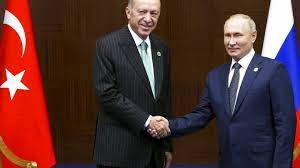– Türkiye is trying to take advantage of its good geographical location to become an energy hub between Russia, the world’s top exporter of natural gas, and the European market, even as the EU is trying to reduce its dependence on Russian energy after the special of the latter’s military operation in Ukraine, but experts say this is a bumpy and challenging road.
Türkiye is located in a geographically ideal place to supply energy to Europe. Its transcontinental location is a great advantage,” said Kerim Has, a Moscow-based analyst for Russian and Eurasian affairs.
Türkiye is home to seven international natural gas pipelines running from east to west, and four onshore LNG (liquefied natural gas) terminals and floating storage units, all in the western part of the country.
He has singled out the TurkStream pipeline, which runs directly from Russia to the Thracian region of Türkiye across the Black Sea, as the best option.
“It is not currently used at full capacity and could provide Europe with much-needed gas,” he explained.
The Blue Stream, another major pipeline through the Black Sea that has the capacity to transport 16 billion cubic meters of natural gas per year from Russia to Türkiye, may also be part of the infrastructure that could eventually make Türkiye a hub. Has pointed out.
Turkish President Recep Tayyip Erdogan said in October that he had agreed with his Russian counterpart Vladimir Putin on the proposal to build a natural gas hub in Türkiye, and Europe can secure its supply from the Turkish hub.
Erdogan’s comments came after the Nord Stream pipelines, which carry gas from Russia to Germany across the Baltic Sea, were damaged in a series of explosions in late September.
“With clever energy diplomacy and strategic vision,” Türkiye could become a “middle man” in natural gas sales to Europe in the long term, as it already imports significant amounts of gas from other big producers such as Iran and Azerbaijan, he said. You have.
“Supplying Russian gas to the EU would give Türkiye a strategic advantage in its ties with Europe, making it a safe energy corridor in the continent’s time of need,” the analyst said, adding that it could also cement growing energy ties between Ankara and Moscow. .
TurkStream branches off at Türkiye, with one line supplying gas to Türkiye and the other to Europe. Each line has an annual capacity of 15,750 million cubic meters.
According to experts, the pipeline could also be expanded with two new lines with a combined capacity of 31 billion cubic meters to supply European consumers via the southeastern European countries of Bulgaria, Romania and Hungary, but it will take time and money.
Time is more of an issue than investment, according to independent energy analyst and consultant Ali Arif Akturk, who estimated the cost of building two additional pipelines for TurkStream over two years to be US$10 billion.
He is skeptical about the viability of the Russian idea in the current geopolitical circumstances, as Brussels is unlikely to give such a project the green light.
“Currently, the political and economic climate is not favorable for such a project. While there is a conflict in Ukraine, the risk of a recession in Europe and rising global interest rates are real challenges,” he said.
In addition, the Turkish government may also refrain from making any critical financial moves ahead of next year’s general elections, Akturk added.
However, Erdogan’s administration would draw up a roadmap to turn the country into a gas hub by the end of this year, Turkey‘s Minister of Energy and Natural Resources Fatih Donmez said in an interview with TRT television channel. Have at the beginning of this month.
In a video message during a gas handover ceremony in the northern Black Sea province of Kastamonu, Erdogan said his government is taking steps to turn Turkey into a natural gas hub “where natural gases compete between yes and the reference price is set in your region”. according to a statement issued by the Turkish presidency on November 12. ■
(Xinhua)








Your article helped me a lot, is there any more related content? Thanks!